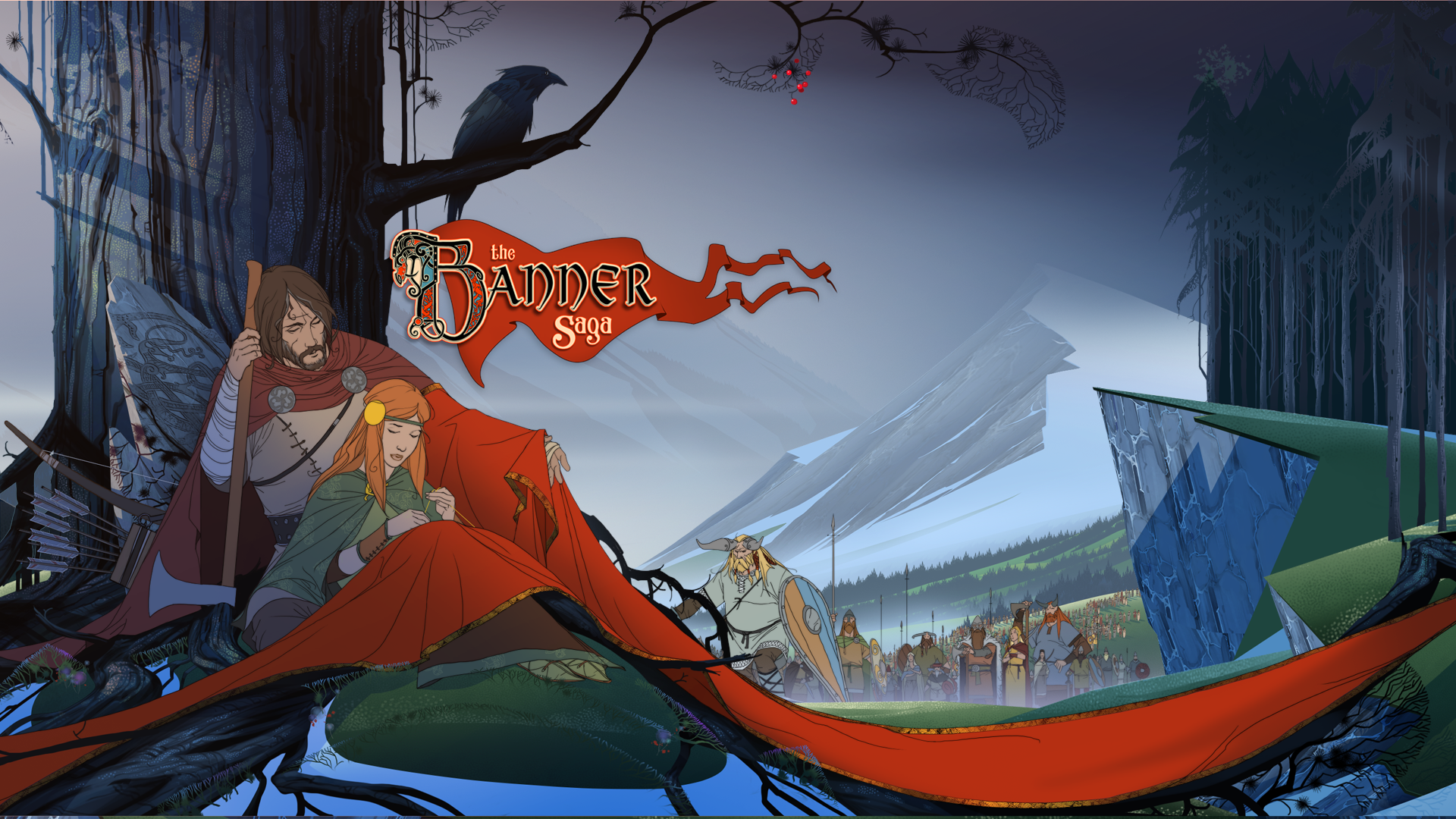The Banner Saga is a game of great renown – there is no arguing about that. Suffice to say that it already inspired the whole sub-genre of games that combine deep non-linear story, management, and tactical battles. Pyre and Ash of Gods being most well-known examples.
Though come to think of it, there already were games with a similar premise. Like Dead State or even Tactics Ogre, if you dig really deep. So maybe the place of Banner Saga in gaming history is not that certain? Or maybe I’ve just put a cart before the yox.
The Story First
The world of Banner Saga is definitely worth to be checked out. The lore, inspired by Norse Mythology, is very rich – just look at the map that marks all the cities, roads, and locations of any importance. And it’s not just names – clicking on them makes a short description pop up about what happened there and why is it significant.
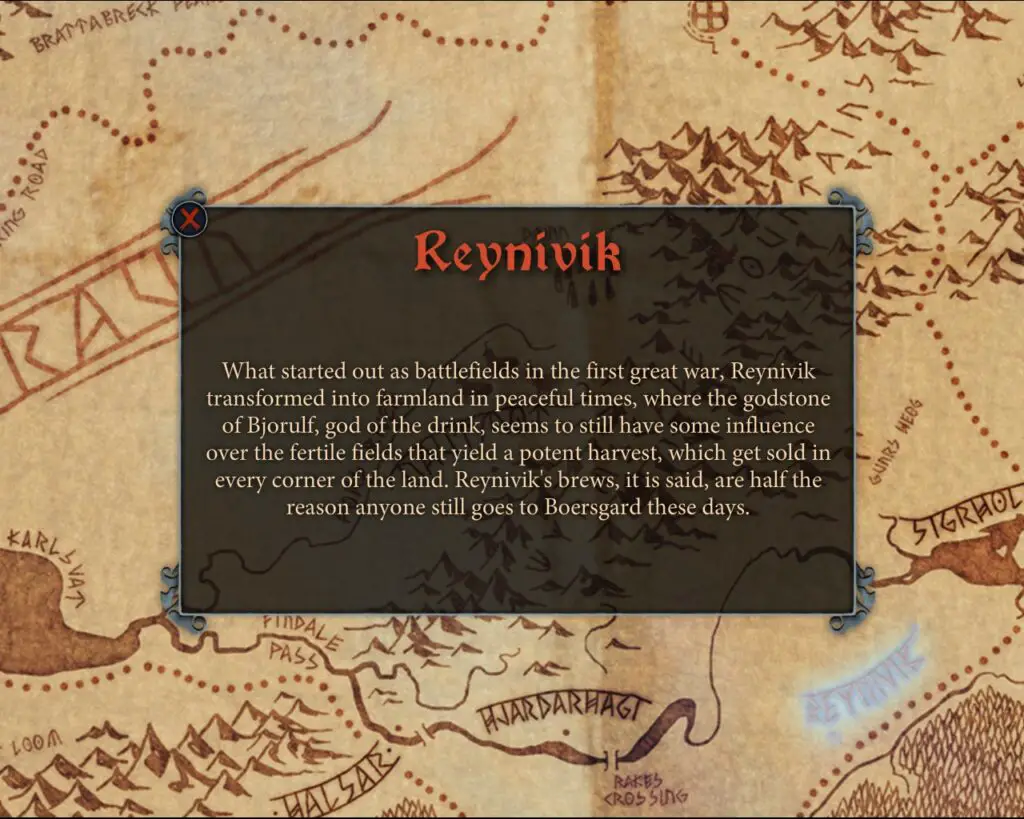
Too bad you don’t have a similar way to learn history. You have a lot of things to piece together. Passing conversations mention two Great Wars between humans, varls, and dredge.
Varls are horned giants that were created by some god to combine the best parts of humans and animals. It’s hard to say if it was a success but they are formidable warriors – that’s for sure. And dredge, created by another god, definitely didn’t turn out good for everyone. Terrifying stone warriors nearly wiped varls and humans in the last war.
And there is, of course, the opening narration saying that gods are dead. Yes. The setting is essentially dark fantasy post-apocalypse. With ice-covered wastelands, roaming bandits, and a general sense of uneasiness for peoples that are now all on their own. Especially in this time, when the sun had literally stopped in the sky, dredge return in force and something even more threatening is on the horizon.
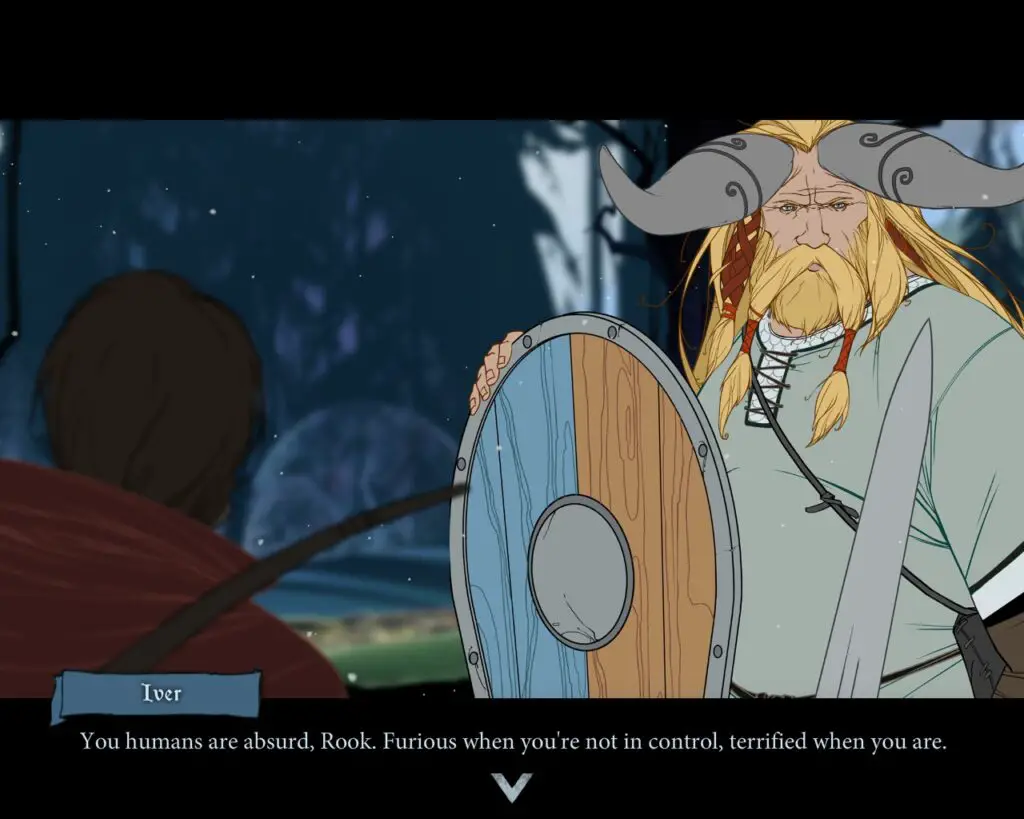
Sound and visuals, while quite minimalistic, totally support the game’s atmosphere. Be it VN-like dialogs with animated character portraits or a caravan moving across desolate land, all look like a piece of classic animation. Imagine Disney feature films, if they had a serious story and deep characters.
Choose Wisely
The story itself essentially is confined to two caravans. The first one is an escort for human prince Ludin, who goes to the varl capital to purpose a new alliance. It’s more of a trade agreement initially but later you learn about dredge threat. Varl leaders Hakon and Udin (you play from their perspective) now have to hurry and warn the others, battling dredge armies along the way.
Another protagonist, Rook stumbles on dredge when hunting with his daughter Alette. They return to their town barely in time to warn everyone about the impending attack. And after the battle, it’s just a chase against the time and incoming dredge. Managing supplies in Rook’s caravan is especially tough if you decide not to risk and miss an opportunity to stock more food at the start.
Choices in Banner Saga aren’t much different from ones in TellTale titles or similar adventure games. Some situations are pretty straightforward, others offer a twist or two. And you can never say which is which on your first walkthrough. Only on your second try will you know that food supplies from certain merchants are spoiled and will cause part of your fighters to become ill. Or that you should offer certain random warriors you meet to join, while others will be bandits you need to fight.
At least there is no cheap “one or the other of your favorite characters will die” dilemma (well, almost). All decisions you make on the road will have clear enough advantages or disadvantages. Boost morale or keep more supplies. Get an artifact or additional “renown” (that’s actually a very precious resource). Or, in case of a ‘war event’, you must always decide between a more difficult fight with dredge and an easier one but with more casualties in the caravan.
Way of the Warrior
Though don’t think to keep everyone alive just by charging into the most difficult battle. Some fights you wouldn’t be able to win because of the sheer number of enemies. Or because the characters that you can take on the battlefield aren’t strong enough.
Your roster consists of the main characters of the story. Hakon, Rook, Ludin, Alette, and other people whom you meet along the way. Humans and varls, men and women – each one has a unique ability and varied characteristics like strength, armor, will, etc.
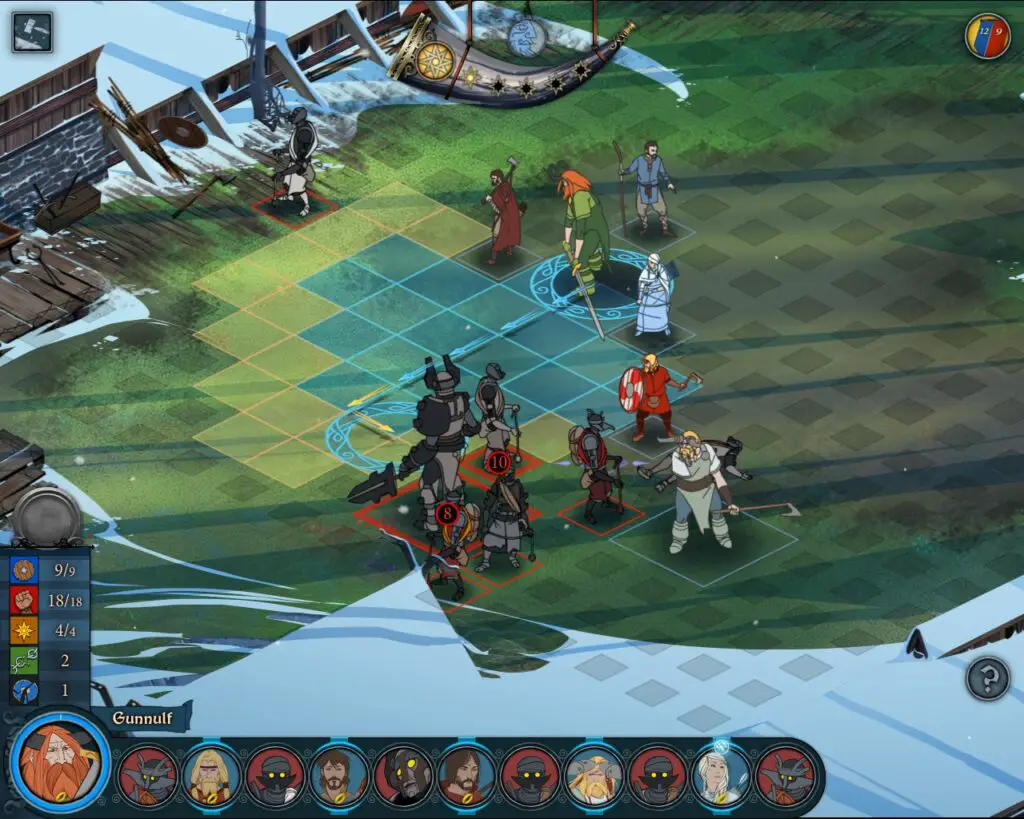
Strength is the most important stat as it is both health and damage rate. So be careful – if a warrior’s health drops so drops the damage. Luckily the Armor stat can absorb damage and if it’s higher than the strength of the attacker, you even have a chance to completely deflect the blow. Unless the enemy will go directly for the armor – in that case, the blow will rip a few points of armor and you have no chance to avoid that.
Will is spent on special abilities. Alette’s arrow breaks armor on several targets in a row, Hakon’s “Sunder Impact” damages enemies adjacent to the target, Ludin makes his target bleed and lose health while moving… Each ability can turn the tide if used at an appropriate time. Or you can spend Will on the increasing force of the normal attacks. Imagine tearing 5 points of armor instead of just 2!
However, the most original rule of the combat is that sides ALWAYS take turns. Even if the enemy has just two warriors and you – six, those two will move several times per turn. And that can lead to some, shall we say, interesting consequences and as a result counter-intuitive tactics.
How It Comes Together
Winning battles without losses is important. While your warriors can’t die in battle, if they fall, they’ll get wounds that reduce their strength in subsequent fights. And the only way to heal those wounds is to make a camp and rest. The deeper the wounds, the more rest is needed.
But each day of rest means more time and supplies spent. If you run out of food your caravan, your fighters and clansmen will start to die, making ‘war events’ more difficult. And on top of that Morale will decline more than usual, reducing the Will of your characters at the start of new battles.
Yes, you can avoid *some* of the fights. But I wouldn’t advise that unless you face really grave losses. “Renown” that you’ll gain by defeating enemies is a precious resource for which you can buy food that will allow extra days of rest and talismans that grant your fighting characters additional perks or stat raise. And even levelling up your characters requires renown. There is always too few points.
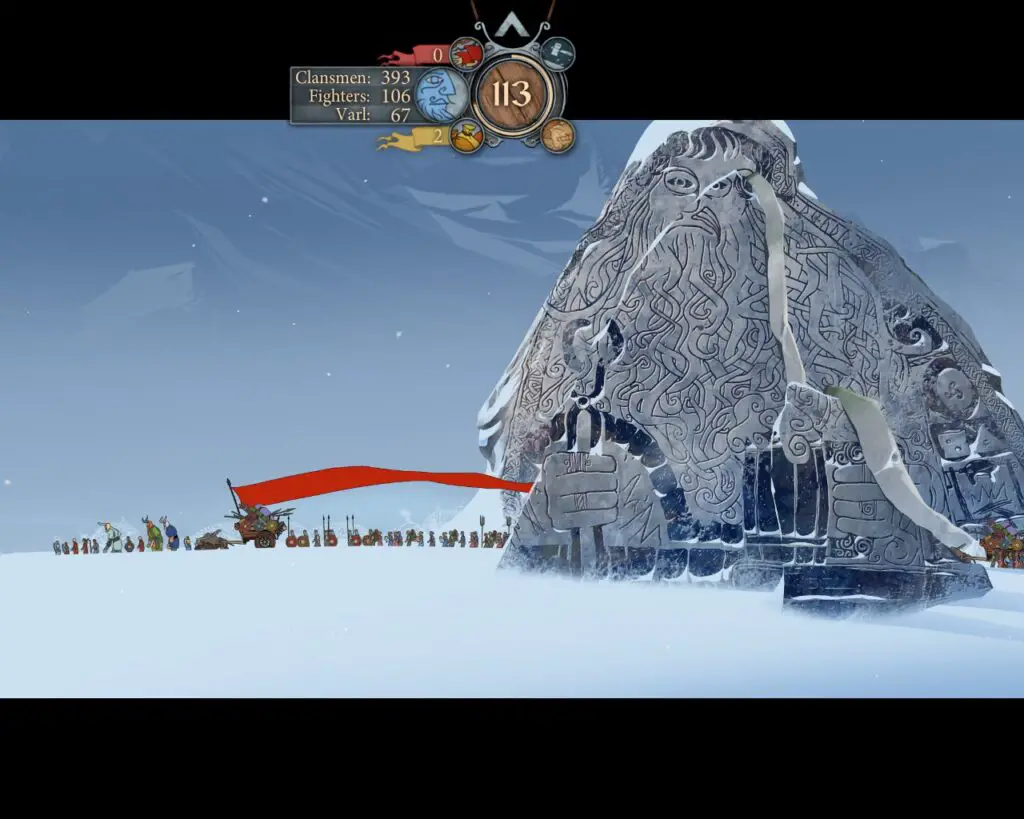
And as if managing to balance your supplies, morale, and wounded wasn’t tricky enough, various story events will interfere with your plans on regular basis. Sure, sometimes surprises are pleasant, like a squad of warriors joining with additional supplies or reaching a destination lifting everyone’s spirit. But other times you’ll have your supplies stolen, bad news undermining Morale, and worst of all – one of the main characters die or leave. If you had given an item to that character you often don’t even get a chance to take it back.
A Good Start
The story is definitely the strongest part of The Banner Saga. Which wouldn’t be a surprise for those who knew that it was written by former BioWare (2013 BioWare, to be exact) writers.
Not only it tells a captivating saga of hope and struggles against the overwhelming odds in a bleak world. Tough situations, made not just by the writer’s whim, but by the game’s own rules that force you to face possible consequences, like starvation or death – that’s what makes you realize how not every decision is cut and dry, and weigh your decisions carefully as it would be in real life.
However, that “real life” thing doesn’t cover tactical battles and the inability to take items from characters at any moment. Former is in the game to provide a challenge and additional aspect of management. The latter, well, it just annoyed me at most unexpected moments of the game. So I would highly recommend playing on “Easy” first to learn of all the bumps and try the hardest difficulty only on the second attempt. Especially for the game save to import into Banner Saga 2.

